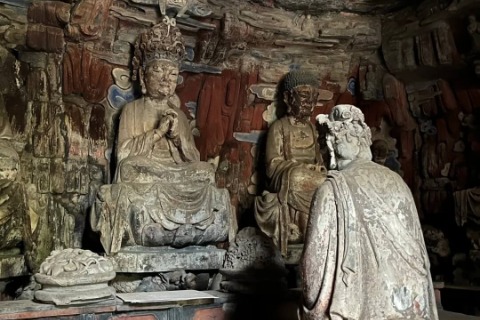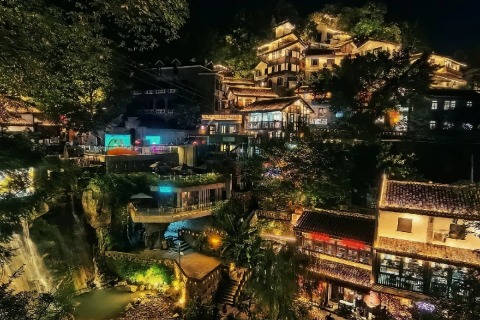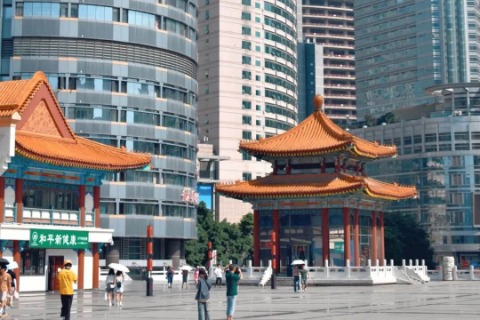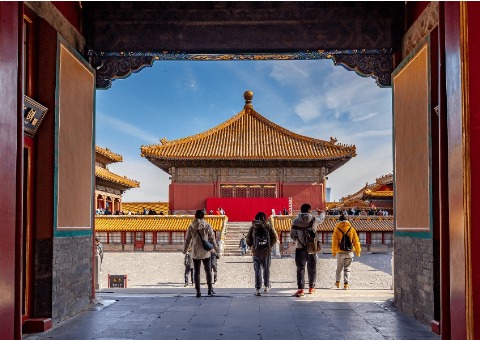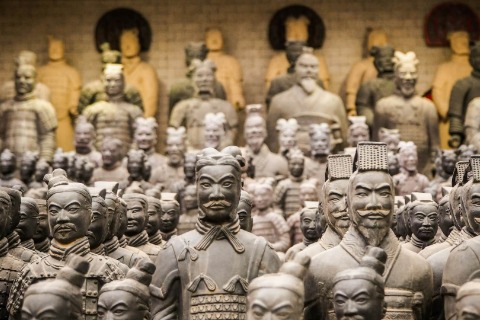Chengdu Panda Reserve
The largest captive breeding facility for giant pandas in the world
The Chengdu Panda Reserve is the largest captive breeding facility for giant pandas in the world, housing one-third of the global captive population. As of 2024, the Chengdu Panda Reserve has over 240 pandas. The reserve features a panda nursery and a cub feeding center that showcase the education and growth of panda cubs. The wild training center allows visitors to learn about pandas in their natural state. The Panda Museum offers educational information about giant pandas and displays the research achievements from the Chengdu Panda Research. The reserve welcomes tens of thousands of visitors every day, especially during Chinese holidays, when daily attendance can reach up to 90,000. Today, panda travel has become a key route for a trip to China.

Table of Contents
Highlights of Chengdu Panda Reserve
Red Panda Birth Center (Chinese name: 小熊猫产房)
The best time to visit the Red Panda Birth Center is during the day, as red pandas are usually more active then. During your visit, pay attention to their activities in the trees, as well as how they forage and play. Red pandas have distinctive features, including reddish-brown fur and unique black eye patches. They are generally smaller than giant pandas and have brighter coloration. Red pandas love to climb and spend much of their time in trees, mainly eating insects, fruit, and tender leaves. They are nocturnal, resting in the trees during the day.

Moon Birth Center (月亮产房)
The Moon Birth Center features densely packed, low trees that create an ideal environment for panda cubs to sleep. Located in the core area of the Chengdu Panda Reserve, it is responsible for the breeding of giant pandas and is named for its moon-like shape. The center has over 300 meters of circular pathways where visitors can see many adorable and lively pandas under one year old. The Moon Birth Center is open daily from 7:30 AM to 6 PM.

Star Birth Center (星星产房)
The best time to visit the Star Birth Center is from September to October, as this is when you can see the newborn panda cubs. During other times, like June, you might not see any newborns, but you can catch a glimpse of some juvenile pandas. The juvenile pandas at the Star Birth Center usually stay indoors, and there’s also a souvenir shop nearby where visitors can spend some time.

Sunrise Pavilion (旭日馆)
The Sunrise Pavilion is mainly used to showcase the lives and natural habits of giant pandas. By observing pandas in their natural behavior, researchers from panda research can gain insights into their dietary habits, breeding practices, and interactions with other species.

Panda Theater (熊猫剧院)
The China Panda Reserve Chengdu features the popular Panda Theater. The main performance is the musical “Panda,” which tells a story about love, growth, and harmonious coexistence. Through this musical, it showcases how magical animals, represented by giant pandas, live in harmony with nature and embrace life in Chengdu, Sichuan. The musical incorporates elements of Sichuan opera, Sichuan-style hip-hop, and traditional Sichuan juggling, using local dialects for dramatic expression.

Villa No. 1 (1号别墅)
The Chengdu Panda Base China features Villa No. 1, a lively place where giant pandas play and interact. This villa includes indoor living spaces as well as outdoor activity areas that mimic their natural habitat. Information boards in Villa No. 1 provide details about the pandas currently residing there, allowing visitors to watch well-fed pandas frolicking on wooden structures. There’s also a lounge where, on hot days, pandas retreat to enjoy the air conditioning, and at this time, visitors can only observe them through the glass.

Villa No. 2 (2号别墅)
Villa No. 2 is located at the northern edge of the Chengdu Panda Reserve, adjacent to the beautiful Infinite Hills area, making it a popular spot for observing giant pandas. The villa features an outdoor garden and an indoor lounge, providing a comfortable living environment. Visitors can see pandas of various ages, including sub-adult pandas, and observe their daily activities up close. It’s recommended that guests arrive early at Villa No. 2, as pandas are most active in the morning and evening. On sunny days, the pandas look even cuter in the sunlight, making for better photo opportunities.

Villa No. 6 (6号别墅)
Villa No. 6 is home to the popular panda Hua Hua, who is a favorite on social media. Many visitors come to the Centre Panda Chengdu specifically to see her. Hua Hua is a very active giant panda; she loves to do somersaults, climb trees, and even greet guests. While waiting in line, visitors have the chance to witness Hua Hua’s adorable antics.

Panda Tower (熊猫塔)
The Panda Tower is a landmark at the Chengdu Panda Reserve, inspired by pandas’ favorite food—bamboo shoots. Standing at 69.8 meters tall, the tower features an elevator, though many people choose to walk up. From the top of the tower, visitors can enjoy a panoramic view of the entire panda base and the surrounding city landmarks.

Adventure Valley (冒险溪谷)
The Adventure Valley at the Chengdu Panda Base China is the area with the highest concentration of panda enclosures. Adventure Valley includes seven panda houses: Shanyue Pavilion, Yunyu Pavilion, Qiuyue Pavilion, Wangyue Pavilion, Mingyue Pavilion, Jiangyue Pavilion, and Lanyue Pavilion. Visitors can observe the pandas’ behavior at any time, and it’s a great spot for feeding them bamboo shoots. When the pandas are focused on eating, guests can enjoy close-up views of their adorable antics. The west gate of the Chengdu Panda Reserve is the closest entrance to Adventure Valley, making it an ideal first stop for visitors.

Practical Travel Tips
- The Chengdu Panda Reserve has no on-site ticket sales; tickets can only be purchased online through the official website. Please book at least 7 days in advance. There are 60,000 tickets available each day, with 30,000 for the morning and 30,000 for the afternoon. Tickets are valid for the day of your visit, and a cancellation fee applies for refunds.
- The Panda Museum is closed on Mondays, and the Panda Tower is closed on Tuesdays, except during Chinese public holidays.
- Make sure to wear comfortable athletic shoes, as most of the paths at the panda reserve involve uphill and downhill sections, which can be physically demanding.
- If you’re bringing a baby, you can rent a stroller for an hourly fee, which can be taken on the sightseeing bus.
- If you’re not driving, it’s recommended to enter through the west gate and exit through the south gate. Exiting from the west gate requires a long walk and includes stairs, which may not be convenient for parents with babies. The distance between the west and south gates is ten kilometers, so be sure to plan your entry point in advance.
- The pandas are most active from 9 to 11 AM, so plan your visit accordingly. If you go in the afternoon, arriving after 2 PM is great for seeing the keepers feeding the pandas.
- The performance time for the musical “Panda” is from 11:00 to 11:45 AM and from 2:00 to 3:10 PM.

Q&A About Chengdu Panda Reserve
1. What is the typical lifespan of a giant panda?
Giant pandas typically live for 20 to 30 years. In the wild, their lifespan ranges from 18 to 20 years, while in captivity, Chengdu pandas can live beyond 30 years.
2. Do panda bears in China only eat bamboo?
Giant pandas primarily eat bamboo, which makes up 99% of their diet, but they also consume other foods. They are highly dependent on bamboo; without it, they could starve. Pandas have been eating bamboo for at least 7 million years, and it has been their sole food source for about 2 million years. This indicates that their body structure and dietary habits have fully adapted to a bamboo-based lifestyle. They especially enjoy fresh bamboo shoots, which are rich in protein, sugar, and fat. During the bamboo shoot season, pandas can eat up to 40 kilograms of shoots each day. In addition to bamboo shoots, they also eat tender bamboo leaves and the upper parts of bamboo stalks, while generally avoiding the lower parts.
3. Are pandas aggressive like other bear species?
Giant pandas can be aggressive. Although they usually display gentle and adorable behavior, they still retain certain characteristics of carnivorous animals and can show aggression under specific circumstances. With sharp claws and strong bite force, they are capable of defending themselves when necessary. Pandas can become irritable when startled or during mating season, potentially attacking perceived threats. Pandas in the wild occasionally hunt small animals, further demonstrating their aggressive traits.
However, giant pandas typically do not actively attack humans or other animals in their natural environment. They are sensitive creatures and usually avoid contact with people. In settings like zoos or reserves, such as the Chengdu Panda Research Base, pandas generally do not exhibit aggression toward their caretakers, as they are familiar with human voices and scents from a young age.
4. Can giant pandas climb trees?
Giant pandas are excellent climbers. They are skilled at climbing trees both in the wild and in captivity. Their affinity for climbing is closely related to their survival needs; especially when they sense danger, wild pandas quickly climb to the treetops to escape predators.
5. Are giant pandas unique to China?
Yes, pandas are a species unique to China. They have existed on Earth for at least 8 million years. The global wild population of pandas is around 1,900, while there are over 700 in captivity.
6. Do pandas live in Tibet? Where pandas are mainly found?
Pandas do not live in Tibet. Giant pandas are primarily found in the temperate forests along the eastern edge of the Tibetan Plateau in southwestern China. These areas have a cool, humid climate, with humidity often exceeding 80%. The rich soil and dense forests provide excellent food sources and water for the pandas. Their habits, as wild pandas, are well adapted to this environment. They prefer to live in dense bamboo forests at altitudes of 2,600 to 3,500 meters, where they are skilled climbers and enjoy playing. Climbing trees is often a way for the weaker pandas to avoid stronger ones, especially during courtship, when escaping danger, or when encountering one another.
7. Besides the Chengdu Panda, where can we see pandas?
Wolong Giant Panda Breeding Center: Established in the 1980s, it is China’s largest and most famous panda conservation base. This center was home to the world’s first pair of twin pandas and currently houses over 60 pandas, making it one of the earliest and most prolific panda breeding facilities.
Dujiangyan China Panda Park: Located in the Shiqiao community of Qingcheng Mountain Town, Dujiangyan City, this park serves as a main venue for international and domestic panda research and cooperation, focusing on scientific research and collaborative efforts.
Bifengxia Panda Base (near Ya’an): Situated within the Bifengxia Scenic Area in the Yucheng District of Ya’an, this is a natural habitat for giant pandas. In addition to viewing pandas, visitors can enjoy the natural scenery of Bifengxia, including small bridges and waterfalls.
Chongqing Zoo: The Panda Zoo here has 22 giant pandas, making it the zoo with the largest number of pandas among all zoos in China.
Beijing Zoo: One of the largest zoos in China, it currently has over a dozen giant pandas, allowing visitors to get up close and personal with them.
Hours and Fees
Hours
- From 7:30 AM to 5:00 PM. Morning ticket entry is from 7:30 AM to 12:00 PM, and afternoon ticket entry is from 12:00 PM to 5:00 PM. The park closes at 6:00 PM. In winter, it opens at 8:00 AM and closes at 5:30 PM.
Admission
- 55 CNY (approximately 8 USD) per person
- Please note: The panda base has suspended on-site ticket sales. All tickets must be purchased online in advance.

How to Get to the Chengdu Panda Reserve
By Bus
- The bus routes to the Chengdu Research Base of Giant Panda Breeding include routes 198, 87, 655, and 198A.
By Subway
- To reach the south entrance of the Chengdu Panda Reserve: Take Line 3 of the subway to Panda Avenue Station (熊猫大道站). Exit from Gate A or D, walk 10 meters, and then take bus 408 to the south entrance of the panda reserve.
- To reach the west entrance of the Chengdu Panda Reserve: Take Line 3 of the subway to Military General Hospital Station (军区总医院站). Exit from Gate B and walk 280 meters to the bus stop for route 409. Then take bus 409 to the west entrance of the panda reserve.



